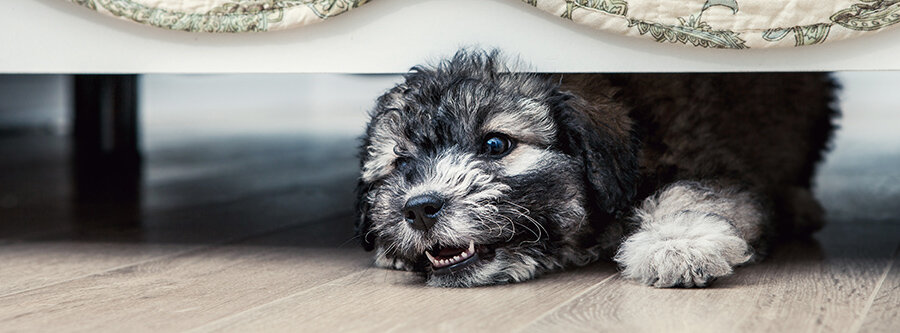
Hearing your Labradoodle puppy growl for the first can be pretty surprising. Although we typically think of growling in the same way as biting, it’s important to understand why the puppy is growling before deciding if it’s cause for concern and how exactly to handle it.
So, why is my Labradoodle puppy growling? Growling is a normal response for a dog, even a puppy. It can mean they’re frightened, alarmed, angry or just trying to play. Growling is one of their main forms of communication and is often used to express that something is happening that’s bothering them. Dogs that are discouraged from growling may go directly to biting if provoked. So it’s important to understand what provokes your Labradoodle to growl.
What Does Growling Mean for the Dog?
We could probably have the exact answer to this question if only dogs could talk. Unfortunately, dogs can’t talk and tell us what’s on their minds or what’s bothering them. This is the main reason why dogs growl, so it’s important that you listen to what your dog is trying to say to you. If he’s growling, he’s doing it for a reason.
Seldom will you see a dog, especially a dog as friendly as a Labradoodle, growling for no reason. Growling is a dog’s language, and it’s important that you learn how to interpret his language. There are certain times a dog will growl, and it’s perfectly normal. If a dog is chewing on a bone and another dog comes along and tries to take it away, it’s pretty likely the first dog will begin growling.
This type of growling is natural in the canine world. Puppies often growl at their siblings when they play, and this type of growling is also very normal. However, certain types of growling are not normal and should not be ignored. Growling means the dog is feeling emotional about something, and it’s important that the owner knows what it means. This is best accomplished by observing your dog’s body language and what circumstances bring on the growling.
Common Triggers/Causes for Growling
If a dog is growling, something has set him off or triggered his feelings. Dogs or puppies may growl in and of the following situations:
- Alert growl – If the dog is suddenly surprised by something he’s never seen before, his reply might be to growl.
- Fear growl – This is most common with puppies. When something frightens them, they often move backward, stiffen their body language and begin to growl.
- Possessive growl – The possessive dog will growl if someone tries to take away its toy, bone or some other possession that the dog does not want to share.
- Territorial growl – This growl usually takes place when someone has come to the dog’s home and is “invading” his space.
- Food protection growl – Even the friendliest dog may growl if someone or another dog is attempting to steal his food or if he feels they’re about to steal it.
- Painful growl – Growling is often the only thing the dog can do when he is in pain and needs help.
Dogs are usually friendly animals by nature, and this is especially true with Labradoodles. Labradoodles are known for their gentleness, loyalty, and friendly personality. If your Labradoodle is suddenly growling at someone or something, it’s important to acknowledge these triggers and try to eliminate them or teach the dog to deal with them in an appropriate manner.
Is The Growling Playful?
When we hear of a dog growling, the first thing that comes to mind is aggression or a dog being ready to bite. This is not always the case because there is such a thing as playful growling, especially with puppies. A big part of a puppy’s growling is playing. Although it may sound vicious, it’s just the puppy trying to show off his toughness to another puppy. It’s important to be able to identify if the growling is playful and friendly or something entirely different.
You should be able to tell if a puppy is playful growling just by looking at his body. The puppy will move around quickly, arch his body and almost pounce at the other puppy while also wagging its tail. If it’s not playful growling, the puppy will stand his ground, show teeth and may have his hair standing up on the ridge of his back.
In many cases, the pup’s body will stiffen and almost freeze in its spot or possibly move backward. The same can be said for older dogs. It’s all about watching the dog’s body language. If a dog is growling in a playful manner, the dog will usually wag its tail and stop growling as soon as you call him by name. Once an owner is able to identify the dog’s body language, he’ll be better able to know when it’s necessary to address the growling.
Identifying What Triggers Growling And Preventing It
In most cases, you’ll have a general idea of what is causing the dog to growl. Identifying the cause of a dog’s growling requires observing the dog while he’s growling. What made him start growling? What was he doing prior to the growling? Is there something new in “his space”? Is he responding to your voice?
Your puppy may softly growl at you when you’re holding and petting him. But, it will be a soft, low growl that’s probably accompanied by a relaxed body. It’s just the puppy’s way of displaying comfort and security. By observing what made the dog begin to growl, it’s much easier to get the dog to stop growling.
The best way to identify the cause, other than monitoring your dog every second of the day, is to see where the dog’s eyes are focused and what type of body language the dog is giving off. Does he appear to be backing up in fear? Is he holding his ground and growling deeply from the throat with his hair on end? Once you observe the dog’s demeanor, it will be much easier to identify the cause.
This does not mean that the dog is justified in growling. It just means that you can understand why he’s growling, which can make it easier to prevent it in the future. Socializing your Labradoodle around as many people and things as possible as a pup will make a big difference in who he responds to different things as an adult. Growling should be addressed as early as possible. The more secure the dog feels, the less likely he will be to growl.
If it’s possible to remove the situation that makes him growl, remove the situation. If you’ve determined the cause of the growling and it cannot be removed, bring your dog to these situations in baby steps. When the dog is relaxed, praise him and give him treats. You may want to give him a small treat to distract him just seconds before he’s about to growl.
If you feel like you’ve taken every step to prevent your dog from growling and it’s not working, consider speaking to a professional trainer and getting some ideas on what you can do. You may also want to enroll the dog in a basic dog obedience class. Socialization is a big part of dog obedience training.
If My Dog Growls Does It Mean He Will Bite?
Just because a dog is growling does not mean he’s automatically going to bite. For years, we’ve been told to pay attention to a dog that’s growling because if he’s growling, his next step will be to bite. In some cases, this may be the case. When a dog is growling, it’s usually his way of giving out a warning. If the warning is not taken seriously, the dog could bite, and he might not think he’s doing anything wrong.
Many people that have been bitten by dogs claim that the dog was growling first, but the person didn’t believe the dog would bite. This is why it’s so important to identify the growl and know what caused it. Seldom will a dog bite someone without first giving out some sort of warning, and the warning is usually aggressive barking or growling.
Related Questions
Do Labradoodles bark a lot?
Labradoodles bark just like any other dog but are generally not excessive barkers. As puppies, they may bark more because they’re learning new things. By the time they’re adult dogs, they generally only bark when they feel it’s necessary.
Are Labradoodles good guard dogs?
Labradoodles are intelligent, loyal and friendly dogs that make good family watchdogs, However, their even-tempered, gentle personalities do not make them good guard dogs.
That’s It – Now You Know!
Every year more dogs than we can count are labeled as aggressive because of growling. Learning what makes a dog growl can make it a lot easier to eliminate the negative growling and know when it’s an issue. You’ll also be able to acknowledge that a dog can be a happy dog and still growl when the situation warrants it.




